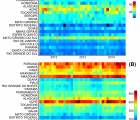Introduction: The New York City Department of Health and Mental Hygiene sought to detect and minimize the risk of local, mosquito-borne Zika virus (ZIKV) transmission. We modeled areas at greatest risk for recent ZIKV importation, in the context of spatially biased ZIKV case ascertainment and no data on the local spatial distribution of persons arriving from ZIKV-affected countries.
Methods: For each of 14 weeks during June-September 2016, we used logistic regression to model the census tract-level presence of any ZIKV cases in the prior month, using eight covariates from static sociodemographic census data and the latest surveillance data, restricting to census tracts with any ZIKV testing in the prior month. To assess whether the model discriminated better than random between census tracts with and without recent cases, we compared the area under the receiver operating characteristic (ROC) curve for each week’s fitted model versus an intercept-only model applied to cross-validated data. For weeks where the ROC contrast test was significant at P < 0.05, we output and mapped the model-predicted individual probabilities for all census tracts, including those with no recent testing.
Results: The ROC contrast test was significant for 8 of 14 weekly analyses. No covariates were consistently associated with the presence of recent cases. Modeled risk areas fluctuated across these 8 weeks, with Spearman correlation coefficients ranging from 0.30 to 0.93, all P < 0.0001. Areas in the Bronx and upper Manhattan were in the highest risk decile as of late June, while as of late August, the greatest risk shifted to eastern Brooklyn.
Conclusion: We used observable characteristics of areas with recent, known travel-associated ZIKV cases to identify similar areas with no observed cases that might also be at-risk each week. Findings were used to target public education and Aedes spp. mosquito surveillance and control. These methods are applicable to other conditions for which biased case ascertainment is suspected and knowledge of how cases are geographically distributed is important for targeting public health activities.

